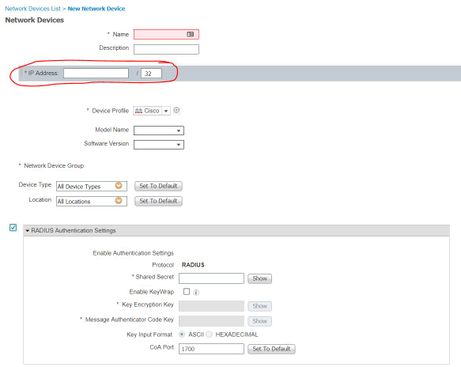Get answers from our community of experts in record time.
Join now- Technical Forums
- :
- Wireless
- :
- Re: Adding Meraki AP as a "network device" on a Cisco ISE
Adding Meraki AP as a "network device" on a Cisco ISE
Solved- Subscribe to RSS Feed
- Mark Topic as New
- Mark Topic as Read
- Float this Topic for Current User
- Bookmark
- Subscribe
- Mute
- Printer Friendly Page
- Mark as New
- Bookmark
- Subscribe
- Mute
- Subscribe to RSS Feed
- Permalink
- Report Inappropriate Content
Adding Meraki AP as a "network device" on a Cisco ISE
Hello everybody,
I tried to search if this had already been discussed somewhere but I can't find anything.
In our environment we use a Cisco ISE used to authenticate our WiFi clients. As you may know, before the authentification takes place, the device sending the RADIUS request has to be added as a "network device" on the ISE with a shared secret to make sure it is allowed to perform the RADIUS request.
In a traditional Cisco WiFi deplyoment with controllers all we had to do was add all our controllers to this list, which was manageable (<10). Now, is there any best practice on how to do this when we have potentially thousands of Meraki APs sending RADIUS requests to our ISE (since there is no controller anymore in the Meraki world) ?
- Is there any integration between the ISE and the Meraki dashboard to automatically trust and configure the Meraki APs on the ISE once they are added to the dashboard ?
- Should we configure a single network device (for instance with 10.0.0.0/8 range) that will cover all APs, but using the same shared secret ?
Any help would be appreciated !
Thanks.
Solved! Go to solution.
- Mark as New
- Bookmark
- Subscribe
- Mute
- Subscribe to RSS Feed
- Permalink
- Report Inappropriate Content
So I would recommend you use a dedicated management native-VLAN for access points, let them use DHCP because it doesn't actually matter so long as they can connect to the cloud, and in ISE just put in a /24 as the range and call it a day. Works for me 😃
- Mark as New
- Bookmark
- Subscribe
- Mute
- Subscribe to RSS Feed
- Permalink
- Report Inappropriate Content
- Mark as New
- Bookmark
- Subscribe
- Mute
- Subscribe to RSS Feed
- Permalink
- Report Inappropriate Content
This document is quite detailed, I had never seen it before.
That being said it goes a bit quickly on how to configure thousands and thousands of access points :
"Repeat steps 1 through 7 for additional Meraki access points that will be used in the ISE deployment"
I really want to avoid having to manually configure a network device on the ISE everytime we deploy a new AP.
- Mark as New
- Bookmark
- Subscribe
- Mute
- Subscribe to RSS Feed
- Permalink
- Report Inappropriate Content
So I would recommend you use a dedicated management native-VLAN for access points, let them use DHCP because it doesn't actually matter so long as they can connect to the cloud, and in ISE just put in a /24 as the range and call it a day. Works for me 😃
- Mark as New
- Bookmark
- Subscribe
- Mute
- Subscribe to RSS Feed
- Permalink
- Report Inappropriate Content
- Mark as New
- Bookmark
- Subscribe
- Mute
- Subscribe to RSS Feed
- Permalink
- Report Inappropriate Content
Just add a subnet in ISE, such as 10.x.0.0/16 - rather than individual AP IP addresses. You probably only need to define a single subnet to cover every access point.
- Mark as New
- Bookmark
- Subscribe
- Mute
- Subscribe to RSS Feed
- Permalink
- Report Inappropriate Content
One other way you could perhaps tackle this is to combine ISE's bulk import with Meraki's API.
The API call you could use is this one:
GET /organizations/[organizationId]/deviceStatuses
PARAMETERS
None
SAMPLE REQUEST
curl -L -H 'X-Cisco-Meraki-API-Key: <key>' -X GET -H 'Content-Type: application/json' 'https://api.meraki.com/api/v0/organizations/[organizationId]/deviceStatuses'
SAMPLE RESPONSE
Successful HTTP Status: 200
[
{
"name":"My AP",
"serial":"Q2XX-XXXX-XXXX",
"mac":"00:11:22:33:44:55:66",
"status":"online",
"lanIp:"1.2.3.4",
"publicIp":"4.3.2.1",
"networkId":"N_1234"
}
]
